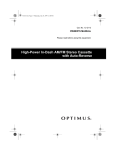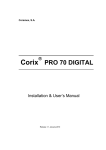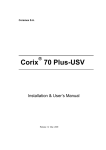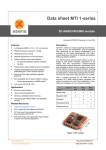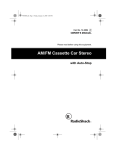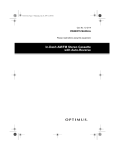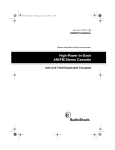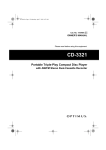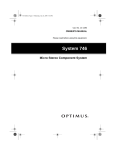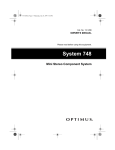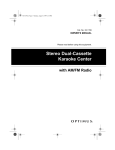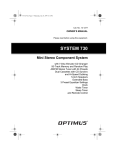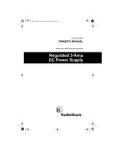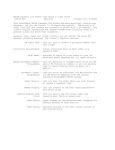Download Radio Shack AM/FM Auto Reverse Cassette Owner`s manual
Transcript
12-2111.fm Page 1 Wednesday, July 14, 1999 11:50 AM Cat. No. 12-2111 OWNER’S MANUAL Please read before using this equipment. High Power AM/FM Stereo Cassette with Auto-Reverse 12-2111.fm Page 2 Wednesday, July 14, 1999 11:50 AM FEATURES You can install your Optimus High Power AM/FM Stereo Cassette with Auto-Reverse in almost any vehicle. The tuner’s digital synthesized circuitry gives you precise tuning and drift-free reception. The auto-reverse cassette deck, memory tuning, and seek tuning all help make your stereo’s operation simple and quick so you can drive safely. Caution: Use common sense. Do not change your stereo’s operation in heavy traffic or during hazardous driving conditions. This stereo’s features include: Anti-Theft Control Panel — lets you quickly remove and store the stereo control panel. This discourages theft because the stereo cannot operate without the control panel. Auto-Reverse — allows continuous tape play. Locking Fast-Forward and Rewind — lets you quickly move the tape to the end or the beginning without holding down the button. Advanced FM Optimizer Circuitry — automatically adjusts the tuner’s stereo separation and high-frequency response to give you the best pos- sible sound, regardless of the signal level. Liquid Crystal Display with Clock — lets you easily see the clock/radio/ cassette deck’s current functions. Band Button — lets you select different memory groups in the AM or FM band with the push of a button. Seek Tuning — searches forward or backward to the next strong station in the selected band. Line-Level Outputs — let you connect the stereo to external power amplifiers, boosters, or other accessories that have line-level input jacks. Memory Tuning — lets you quickly store 12 AM and 18 FM stations into memory so you can quickly tune to those stations. Memory Scan Tuning — scans all stations stored in a selected memory group, playing for 5 seconds on each station. Bass, Treble, Fader, and Balance Controls — let you adjust high and low sounds, the balance between the left and right speakers, and the balance between the front and rear speakers, so you can tailor the sound to suit your preferences. © 1996 Tandy Corporation. All Rights Reserved. RadioShack is a trademark used by Tandy Corporation. Optimus is a registered trademark used by Tandy Corporation. 2 12-2111.fm Page 3 Wednesday, July 14, 1999 11:50 AM Digitally Synthesized Circuitry — gives you precise tuning and driftfree reception. Built-In Noise Suppression Choke — reduces the noise caused by your vehicle’s electrical system. We recommend you record your stereo’s serial number here. The number is on the top of the stereo. Serial Number: ________________ 3 12-2111.fm Page 4 Wednesday, July 14, 1999 11:50 AM CONTENTS Installation .......................................................................................................5 Before You Begin the Installation ...............................................................5 Preparing the Mounting Area ...............................................................5 Routing Speaker Wire .......................................................................... 5 Making the Connections ............................................................................ 6 Using an Adapter Harness ...................................................................6 Connecting Ground, Power, and Optional Components ...................... 7 Testing the Power Connections ........................................................... 8 Connecting Speakers ...........................................................................8 Connecting the Antenna .................................................................... 10 Testing the Connections..................................................................... 10 Mounting the Stereo ................................................................................. 11 Removing the Stereo from the Dash ........................................................12 Connecting Line-Level Components ........................................................13 Using the Control Panel ...............................................................................14 Installing the Control Panel .......................................................................14 Removing the Control Panel .....................................................................14 Basic Operation ............................................................................................15 Adjusting the Controls .............................................................................. 15 Setting the Clock ......................................................................................16 Using the Radio .............................................................................................17 Playing the Radio .....................................................................................17 Memory Tuning......................................................................................... 17 Automatically Storing Stations ...........................................................18 Manually Storing Stations ..................................................................18 Selecting a Stored Station ................................................................. 19 Scanning Stored Stations ..................................................................19 Using the Cassette Player ............................................................................20 Playing a Cassette ....................................................................................20 Fast-Forward and Rewind ..................................................................21 Care and Maintenance ..................................................................................22 The FCC Wants You to Know ...................................................................22 Cleaning the Tape-Handling Parts ............................................................23 Restoring Tape Tension and Sound Quality ............................................. 23 Replacing a Fuse ......................................................................................23 Specifications ................................................................................................25 4 12-2111.fm Page 5 Wednesday, July 14, 1999 11:50 AM INSTALLATION BEFORE YOU BEGIN THE INSTALLATION Preparing the Mounting Area Before you install your stereo, read all the instructions in this Owner’s Manual. You should be able to answer all of these questions about your vehicle’s electrical and sound systems: Before you mount the stereo, read through this “Installation” section to make sure you have all the necessary materials. Then confirm that the stereo fits your vehicle’s mounting area. • Which terminal in my vehicle’s fuse box is for accessories? Caution: Be careful to avoid obstructions behind the mounting surface. • How do I connect a wire to the fuse box? Notes: • Which of the stereo’s wires is the power wire? • Which stereo wires are line-level outputs and which are speaker outputs? Also, be aware that installation in your vehicle might require cutting or modifying your vehicle. Before you mount the stereo, test the connections by temporarily connecting the power wires, speakers, and antenna as described in “Making the Connections” on Page 6. If you plan to use an adapter harness to connect the stereo, see “Using an Adapter Harness” in that section. • This autosound stereo system is a DIN-E size unit that requires a 21/16-inch (52 mm) high by 73/16inch (182 mm) wide by 69/16-inch (161 mm) deep mounting area. • If the mounting area is too large, you might be able to mount the stereo with an in-dash installation kit, available at your local RadioShack store. Follow the installation kit’s instructions to mount the stereo. Routing Speaker Wire If you install speakers, avoid routing the speaker wires near moving parts or sharp edges. You can usually route them along the wiring channel beneath the vehicle’s door facings by carefully removing the molding that holds the carpet in place. After you route the speaker wires, replace the molding. 5 12-2111.fm Page 6 Wednesday, July 14, 1999 11:50 AM MAKING THE CONNECTIONS The supplied harness with the 14-pin connector includes all the lead wires you need to connect the stereo to ground, power, optional components, and speakers. Important: Do not cut these wires. If you cut any wire, you cannot obtain a refund or exchange on this product. RadioShack will provide warranty service if you cut a wire and find the product is defective. You might need additional wire, depending on your individual autosound system, to complete the connections. Your local RadioShack store carries a full line of wire and wiring accessories. Cautions: • For added safety and to protect your stereo, disconnect the vehicle battery’s negative (–) cable before you begin. • You must connect the ground, primary, and memory backup wires first, then make all other connections (as described in the following sections) before you plug the harness with the 14-pin connector into the stereo. If you do not make connections in the order shown, you could damage the stereo if any wire connections are made incorrectly. 6 Using an Adapter Harness If you are replacing an existing stereo or if your vehicle has been factorywired for autosound components, you might be able to use an adapter harness to connect the power and speakers. Your local RadioShack store sells adapter harnesses for most vehicles. Follow the directions that come with the adapter harness to connect power and the speakers. 12-2111.fm Page 7 Wednesday, July 14, 1999 11:50 AM Connecting Ground, Power, and Optional Components Follow these steps to connect the harness with the 14-pin connector to ground, primary and memory backup power, and optional components. 1. Make sure you disconnected the cable from your vehicle battery’s negative (–) terminal. 2. Connect the black ground wire (with in-line filter and fuse box) to a chassis ground, such as a metal screw attached to a metal part of the vehicle’s frame. Be sure the screw is not insulated from the chassis by a plastic part. 3. Connect the red power wire (with in-line filter and fuse box) to a point in your vehicle’s fuse block that has power only when you turn the vehicle’s key to either the accessory (ACC) or START position. This connection turns on and powers the stereo when you turn on the ignition or turn the key to ACC, and turns off the stereo when you turn off the ignition. This prevents your vehicle’s battery from being drained if you leave the stereo on when you turn off the ignition. 4. Connect the yellow memory wire (with in-line fuse holder) to your vehicle battery’s positive (+) terminal or to a point in your vehicle’s fuse block that provides a continuous source of 12 volts. This connection provides continuous power for the stereo’s memory and clock display when the ignition is turned off. 7 12-2111.fm Page 8 Wednesday, July 14, 1999 11:50 AM 5. Cut the loop at the end of the blue wire, strip about 1/2-inch of insulation from the end, and connect it to any optional components, designed to run from a switched source, that you want to turn on and off when you turn the stereo on and off (such as an equalizer/booster or a power antenna). This wire does not provide power to the components. It simply turns them on or off. If you do not use this wire, secure it with a wire tie and do not let it touch metal. Testing the Power Connections Temporarily connect: • The 14-pin connector into the stereo’s 14-pin wiring socket • Your vehicle battery’s negative (–) cable Then turn on your vehicle’s ignition. Verify that everything works properly (the stereo works properly when the display lights and the time display appears after about 5 seconds). Caution: If the display lights but the time display does not appear, the power and ground connections might be reversed. If the stereo does not work, immediately turn off your vehicle’s ignition, then unplug the 14-pin 8 connector and your vehicle battery’s negative (–) cable. Recheck your connections. If the stereo works properly, disconnect: • The 14-pin connector from the stereo’s 14-pin wiring socket • Your vehicle battery’s negative (–) cable Then proceed with the installation. About the Wiring Harness The harness with the 14-pin connector has these labels. SWITCHED POWER LEAD 500 mA MAX (NONE) CLOCK MEMORY (NONE) POWER LEAD GROUND (–) SPEAKER REAR RIGHT (+) SPEAKER REAR RIGHT (–) SPEAKER REAR LEFT (+) SPEAKER REAR LEFT (–) SPEAKER FRONT RIGHT (+) SPEAKER FRONT RIGHT (–) SPEAKER FRONT LEFT (+) SPEAKER FRONT LEFT (–) 12-2111.fm Page 9 Wednesday, July 14, 1999 11:50 AM Connecting Speakers You can connect one or two pairs of speakers to the stereo. 4. Connect the white/black wire to the left speaker’s negative terminal. Connecting Two Pairs of Speakers Cautions: • Be sure your speakers can handle 32 watts of power (16 watts per channel if you connect the stereo to one pair of speakers, or 10 watts per channel if you connect the stereo to two pairs of speakers). Each speaker must have an impedance of at least 4 ohms. Your local RadioShack store carries a full line of speakers. • You must connect a separate wire to each speaker terminal as described. Do not use a common wire or chassis ground for any speaker connection. Connecting One Pair of Speakers If you are using only one pair of speakers, follow these steps to connect the harness to the speakers. 1. Connect the gray wire to the right speaker’s positive terminal. This terminal is usually marked with a plus (+) sign or red mark. If you are using both front or rear speakers, follow these steps to connect the harness to the speakers. 1. Connect the gray wire to the right front speaker’s positive terminal. This terminal is usually marked with a plus sign (+) or red mark. 2. Connect the gray/black wire to the right front speaker’s negative terminal. This terminal might be marked with a minus sign (–) or it might not be marked at all. 3. Connect the white wire to the left front speaker’s positive terminal. 4. Connect the white/black wire to the left front speaker’s negative terminal. 5. Connect the violet wire to the right rear speaker’s positive terminal. 2. Connect the gray/black wire to the right speaker’s negative terminal. This terminal might be marked with a minus (–) sign or it might not be marked at all. 3. Connect the white wire to the left speaker’s positive terminal. 9 12-2111.fm Page 10 Wednesday, July 14, 1999 11:50 AM 6. Connect the violet/black wire to the right rear speaker’s negative terminal. 7. Connect the green wire to the left rear speaker’s positive terminal. 8. Connect the green/black wire to the left rear speaker’s negative terminal. Connecting the Antenna Connect the vehicle’s antenna cable to the stereo’s large, black antenna jack. Testing the Connections Caution: Make sure you have securely made all connections before continuing with the installation. Plug the harness’s 14-pin connector into the 14-pin wiring socket, then reconnect the cable to the vehicle battery’s negative terminal. Turn on your vehicle’s ignition and test the stereo. If the stereo does not work, immediately turn off the ignition, then disconnect the harness‘s 14-pin connector from the stereo’s 14-pin wiring socket and disconnect your vehicle battery’s negative (–) cable. Recheck your connections. After you verify that everything works, make sure the connections are correctly marked or identified. Then follow the instructions in “Mounting the Stereo” on Page 11. 10 12-2111.fm Page 11 Wednesday, July 14, 1999 11:50 AM MOUNTING THE STEREO Be sure you test all connections first, then follow these steps to mount the stereo. 1. Disconnect the cable from the vehicle battery’s negative (–) terminal. 2. Disconnect the wire harness and the antenna. 3. Insert both of the supplied removal keys into the slots at the top left and right sides of the stereo until the keys lock into place, and slide the sleeve off of the stereo. 6. Reconnect the wire harness and the antenna. 7. Slide the stereo into the sleeve until it locks into place. 8. To further secure the stereo, use the supplied hardware to attach one end of the supplied metal strap to the bolt on the back of the stereo. 4. While pressing down and holding the triangle holders on the top of the stereo, remove the removal keys from the slots. 5. Insert the sleeve into the dash. Then secure the sleeve to the dash by bending out the appropriate tabs with a screwdriver. Bend out all the side tabs. 11 12-2111.fm Page 12 Wednesday, July 14, 1999 11:50 AM 9. If necessary, bend the metal strap to fit your vehicle’s mounting area. Then attach the other end of the strap to a solid metal part of the vehicle. This strap also helps ensure proper electrical grounding of the stereo. 4. Insert both of the supplied keys into the slots at the lower left and right sides of the stereo, then slide the stereo out of the dash. 10. Reconnect the cable to the vehicle battery’s negative (–) terminal. REMOVING THE STEREO FROM THE DASH If you ever want to remove the stereo from the dash, follow these steps. 1. Disconnect the cable from the vehicle battery’s negative (–) terminal. 2. Remove the metal strap attached to the back of the stereo. 3. Remove the control panel (see “Removing the Control Panel” on Page 14). 12 5. While pressing down and holding the triangle holders on the top of the stereo, remove the keys from the slots. 6. Disconnect the wire harness and the antenna. 7. Reconnect the cable to the vehicle battery’s negative (–) terminal. 12-2111.fm Page 13 Wednesday, July 14, 1999 11:50 AM CONNECTING LINE-LEVEL COMPONENTS This stereo has pre-amp outputs (phono connectors) for connection to an equalizer/booster, power amplifier, or other device that has line-level inputs. To ensure a low-noise connection, connect a ground wire between the stereo and the additional component. The following diagram shows a typical system using the line outputs. Note: Always refer to the component’s owner’s manual to ensure proper connections. 13 12-2111.fm Page 14 Wednesday, July 14, 1999 11:50 AM USING THE CONTROL PANEL The stereo’s anti-theft control panel must be in place for the stereo to operate. When you remove it, the stereo does not work. This is a simple, but effective security measure. 2. Gently push the left edge of the control panel into the recess until you hear a click. Notes: • The time display turns off when the control panel is removed. • Any stored stations remain in memory when the control panel is removed. INSTALLING THE CONTROL PANEL REMOVING THE CONTROL PANEL 1. Press REL (release). Caution: Avoid pushing on the display or pressing any buttons while installing the control panel. 1. Insert the tabs on the control panel’s right edge into slots in the right edge of the recess. Be sure the tabs fit securely in the slots. 2. Grasp the control panel on the left side and pull it out to remove it. 3. Press the side of the supplied carry case to open it, then store the control panel in it. 14 12-2111.fm Page 15 Wednesday, July 14, 1999 11:50 AM BASIC OPERATION ADJUSTING THE CONTROLS Push BAL — push and rotate to ad- When you listen to your stereo, you can adjust the following controls to suit your listening preferences. ON/VOL — turn clockwise until it clicks to turn on the stereo. Turn ON/ VOL clockwise to increase or counterclockwise to decrease the volume. To turn off the stereo, turn ON/VOL counterclockwise until it clicks. Warning: To protect your hearing, do not listen at high volume levels. Slowly increase the volume to a comfortable listening level. FAD — rotate to adjust the balance between the front and rear speakers. Note: If you have only one pair of speakers, adjust the balance to the center. just the balance between the right and left speakers. BASS — rotate to increase or decrease low sounds. TREBLE — rotate to increase or de- crease high sounds. BND — press to select the desired band and memory group. LOC (local)— press to improve recep- tion of a strong station. AMS — press and hold to automatically scan and store the next six strong stations in the selected band (see “Memory Tuning” on Page 17). M/S — press to select stereo or mono reception. F/C — press to display the current frequency or the clock. 15 12-2111.fm Page 16 Wednesday, July 14, 1999 11:50 AM TUN t or TUN s — repeatedly press to tune down or up a selected band (see “Using the Radio” on Page 17). SEK t or SEK s — press and hold down to automatically tune to the next lower or higher station with a strong signal (see “Using the Radio” on Page 17). SETTING THE CLOCK 1. If the stereo is off, turn ON/VOL clockwise until it clicks to turn it on. Note: The display normally shows the clock. If necessary, press and hold down F/C (frequency/clock) until the clock display appears. 2. Press and hold down F/C, then repeatedly press TUN t until the display shows the correct hour. To quickly advance the hour, press and hold down TUN t. 16 3. Continue holding down F/C , then repeatedly press TUN s until the display shows the correct minute. To quickly advance the minute, press and hold down TUN s. 12-2111.fm Page 17 Wednesday, July 14, 1999 11:50 AM USING THE RADIO PLAYING THE RADIO 1. If the stereo is off, turn ON/VOL clockwise until it clicks to turn it on. The radio automatically tunes to the last station selected. 2. Press BND to select the desired band. AM 1 or AM 2 appears on the display when an AM band is selected. FM 1, FM 2, or FM 3 appears when an FM band is selected. • To improve reception of strong stations, press LOC until LOC appears on the display. • To improve reception of weak stations, press M/S so MO appears on the display. The sound is no longer in stereo, but reception should improve. • If the stereo does not find a strong station when seeking, it searches the band again and stops on weaker stations. 3. Tune to the desired station in one of the following ways. Manual Tuning: Repeatedly press TUN t or TUN s to tune down or up the selected band. Seek Tuning: Press and hold down SEK t or SEK s for about a second to automatically tune to the next lower or higher station with a strong signal. 4. Adjust ON/VOL, FAD, Push BAL, BASS, and TREBLE as desired. Notes: • ST appears on the display when an FM broadcast is received in stereo. • To temporarily display the frequency, press F/C (frequency/ clock). The display shows the frequency for 5 seconds, then returns to the clock display. MEMORY TUNING You can store up to 12 AM and 18 FM stations in memory. Each memory group (AM 1, AM 2, FM 1, FM 2, and FM 3) holds up to six stations. You can let the stereo search for the next six strong stations in a band and automatically store these into a memory group, or you can manually store stations into a memory group. 17 12-2111.fm Page 18 Wednesday, July 14, 1999 11:50 AM Automatically Storing Stations 1. If the stereo is off, turn ON/VOL clockwise until it clicks to turn it on. 2. Press BND until the stereo displays the band and memory group where you want to store a group of stations. For example, to store the first group of AM stations into AM 1, press BND until AM 1 appears. 3. Use either of the tuning methods described in “Playing the Radio” on Page 17 to tune to the frequency just before the first station you want to store. 4. Press and hold down AMS (automatic memory scan) for about 3 seconds. The stereo scans the selected band, and automatically stores the first six stations it finds. The stereo beeps, and the band number, frequency, and memory location number appear on the display when the station is stored. Note: If the stereo cannot find six strong stations, it searches the band again for weaker stations and stores them into any remaining memory locations. 5. Briefly press AMS when the stereo has stored all the stations you want, or when you want to stop searching for stations. 18 Note: If you do not press AMS, the stereo continues to scan the band, tuning to each stored station for about 5 seconds. Manually Storing Stations 1. If the stereo is off, turn ON/VOL clockwise until it clicks to turn it on. 2. Press BND until the stereo displays the band and memory group where you want to store a station. For example, to store AM stations into AM 1, press BND until AM 1 appears. 3. Use either of the tuning methods described in Step 3 of “Playing the Radio” on Page 17 to tune to the station you want to store. 4. Press and hold down the desired memory location button until the stereo beeps once. The volume briefly mutes then returns to normal. The station is now stored in that memory location. The band number, the frequency, and the memory location number appear on the display for about 5 seconds when the stereo stores the station. 12-2111.fm Page 19 Wednesday, July 14, 1999 11:50 AM Selecting a Stored Station To select a stored station, press BND to select the correct memory group. Then briefly press the desired memory location button. Note: Do not hold down the memory location button. This stores the currently tuned station into that location. stations into the selected memory group. 3. To stop scanning when the stereo pauses at a station you want to listen to, briefly press the station’s memory location button. Note: If you do not press a memory location button, the stereo scans the memory group repeatedly. Scanning Stored Stations The stereo’s automatic memory scan (AMS) feature scans all stored stations in the currently selected memory group, pausing for 5 seconds at each station. 1. Press BND until the stereo displays the memory group you want to scan. 2. To start automatic memory scan, briefly press AMS. As the stereo scans each memory location in the memory group, the current memory location number flashes on the display. Caution: Do not hold down AMS. This causes the stereo to automatically seek and store 19 12-2111.fm Page 20 Wednesday, July 14, 1999 11:50 AM USING THE CASSETTE PLAYER PLAYING A CASSETTE Caution: Avoid using C-120 cassette tapes. They are very thin and can easily become tangled in the tape-handling parts. 3. Insert the tape into the cassette compartment with its open edge to the right and the side you want to hear facing up. The tape begins to play. Follow these steps to play a cassette tape. 1. Take up any slack by turning the cassette’s hub with your finger or a pencil. (Avoid touching the tape.) 4. Adjust ON/VOL, Push BAL, FAD, BASS, and TREBLE as desired. 5. Press all the way in to stop the tape and eject it. The radio plays. 2. If the stereo is off, turn ON/VOL clockwise until it clicks to turn it on. 20 Caution: We recommend you press as soon as you finish playing a tape or before you leave your vehicle to release it from the tape-handling parts. This reduces the possibility of a tape being inadvertently tangled or damaged. 12-2111.fm Page 21 Wednesday, July 14, 1999 11:50 AM Notes: • When the tape reaches the end, the cassette player automatically changes the tape’s direction and plays the other side of the tape. Play continues until you press . • During play, you can switch to the other side of the cassette by pressing and at the same time. Fast-Forward and Rewind To fast-forward or rewind the current side, firmly press and hold or depending on which side of the tape is playing. The tape quickly winds. Play resumes when you release the button or when the end of the tape side is reached. To stop fast forward or rewind before the end of the tape, gently press and release the opposite button. Play continues. 21 12-2111.fm Page 22 Wednesday, July 14, 1999 11:50 AM CARE AND MAINTENANCE Your Optimus High Power AM/FM Stereo Cassette with Auto-Reverse is an example of superior design and craftsmanship. The following suggestions will help you care for the stereo so you can enjoy it for years. Keep the stereo dry. If it gets wet, wipe it dry immediately. Liquids might contain minerals that can corrode the electronic circuits. Keep the stereo away from dust and dirt, which can cause premature wear of parts. Handle the stereo gently and carefully. Dropping it can damage circuit boards and cases and can cause the stereo to work improperly. CLEANER Wipe the stereo with a damp cloth occasionally to keep it looking new. Do not use harsh chemicals, cleaning solvents, or strong detergents to clean the stereo. Modifying or tampering with the stereo’s internal components can cause a malfunction and might invalidate your stereo’s warranty and void your FCC authorization to operate it. If your stereo is not performing as it should, take it to your local RadioShack store for assistance. THE FCC WANTS YOU TO KNOW Your stereo might cause TV or radio interference even when it is operating properly. To determine whether your stereo is causing the interference, turn off your stereo. If the interference goes away, your stereo is causing the interference. Try to eliminate the interference by: • Moving your stereo away from the receiver • Contacting your local RadioShack store for help If you cannot eliminate the interference, the FCC requires that you stop using your stereo. 22 12-2111.fm Page 23 Wednesday, July 14, 1999 11:50 AM CLEANING THE TAPEHANDLING PARTS REPLACING A FUSE Clean the tape head after about every 20 hours of playing time. Insert a special head-cleaning cassette (such as Cat. No. 44-1202), and follow the cassette’s directions to clean the tape head. If the stereo does not operate, you might need to replace the red power wire’s fuse with the supplied spare 8.0 amp fuse. If the clock resets or stored stations are lost when the ignition is off, you might need to replace the yellow memory wire’s fuse with the supplied spare 0.5 amp fuse. RESTORING TAPE TENSION AND SOUND QUALITY Check both fuses. If neither is blown, check your vehicle’s fuses and follow the instructions in your vehicle’s owner’s manual to replace them, if necessary. After you play a cassette tape a few times, the tape might become tightly wound on the reels. This can cause playback sound quality to deteriorate. To restore the sound quality, fast-forward the tape from the beginning to the end of one side, then rewind it. Then loosen the tape reels by gently tapping each side of the cassette’s outer shell on a flat surface. Warning: Before you begin, turn off the stereo and your vehicle’s ignition. Then disconnect the cable from the vehicle battery’s negative (–) terminal. 1. Disconnect the red and yellow power wires. 2. Pull up the latch on the red power wire’s filter and fuse box until the holder springs open. Caution: Be careful not to damage the cassette when tapping it. Do not touch the exposed tape or allow any sharp objects near the cassette. 23 12-2111.fm Page 24 Wednesday, July 14, 1999 11:50 AM 3. Unlatch the two latches on the yellow continuous power wire’s fuse holder until the box springs open. 4. If either fuse is blown, replace it. Use only standard 11/4-inch fuses with the proper rating. The red power wire’s fuse must be 8.0 amps, and the yellow continuous power wire’s fuse must be 0.5 amp. Caution: The supplied fuses have the correct Make sure you replace only with another fuse same rating. spare rating. a fuse of the 5. Snap the fuse holder and the latch on the in-line filter and fuse box closed. 6. Reconnect the red and yellow power wires. 24 12-2111.fm Page 25 Wednesday, July 14, 1999 11:50 AM SPECIFICATIONS RADIO Frequency Range IF Rejection Image Rejection Selectivity Signal-to-Noise (S/N) Ratio Stereo Separation Usable Sensitivity FM (Nominal) 87.9-107.9 MHz 70 dB 50 dB 30 dB 55 dB 30 dB 3.0 mV (3% THD) AM (Nominal) 530-1710 kHz 50 dB 50 dB 35 dB 50 dB — 32 mV (20 dB S/N) CASSETTE PLAYER Cassette Mechanism...................................................................... Auto Reverse Wow and Flutter ............................................................ Less than 0.25% WRMS Signal-to-Noise Ratio ..................................................................................50 dB Separation ..................................................................................................40 dB Frequency Response (–3 dB)........................................................ 125-8,000 Hz GENERAL Power Source............................................................. 12 V DC Negative Ground Speaker Output Impedance ............................................................ 4 or 8 Ohms Maximum Power 2-Channel .........................................................................28 Watts/Channel 4-Channel .........................................................................22 Watts/Channel Power Output (10% THD @ 1 kHz) 2-Channel ................................................................16 Watts RMS/Channel 4-Channel ................................................................10 Watts RMS/Channel Chassis Size........................................................ 115/16 ¥ 7 ¥ 515/16 Inches (HWD) (50 ¥ 178 ¥ 151 mm) Weight ............................................................................................... 3 lb (1.3 kg) Specifications are typical; individual units might vary. Specifications are subject to change and improvement without notice. 25 12-2111.fm Page 26 Wednesday, July 14, 1999 11:50 AM NOTES 26 12-2111.fm Page 27 Wednesday, July 14, 1999 11:50 AM 27 12-2111.fm Page 28 Wednesday, July 14, 1999 11:50 AM RadioShack Limited Warranty This product is warranted against defects for 1 year from date of purchase from RadioShack company-owned stores and authorized RadioShack franchisees and dealers. Within this period, we will repair it without charge for parts and labor. Simply bring your RadioShack sales slip as proof of purchase date to any RadioShack store. Warranty does not cover transportation costs. Nor does it cover a product subjected to misuse, accidental damage, alteration or improper installation. EXCEPT AS PROVIDED HEREIN, RadioShack MAKES NO EXPRESS WARRANTIES AND ANY IMPLIED WARRANTIES ARE LIMITED IN DURATION TO THE DURATION OF THE WRITTEN LIMITED WARRANTIES CONTAINED HEREIN. Some states do not permit limitation or exclusion of implied warranties; therefore, the aforesaid limitation(s) or exclusion(s) may not apply to the purchaser. This warranty gives you specific legal rights and you may also have other rights which vary from state to state. We Service What We Sell 10/95 RadioShack A Division of Tandy Corporation Fort Worth, Texas 76102 6A6 Printed in Hong Kong




























